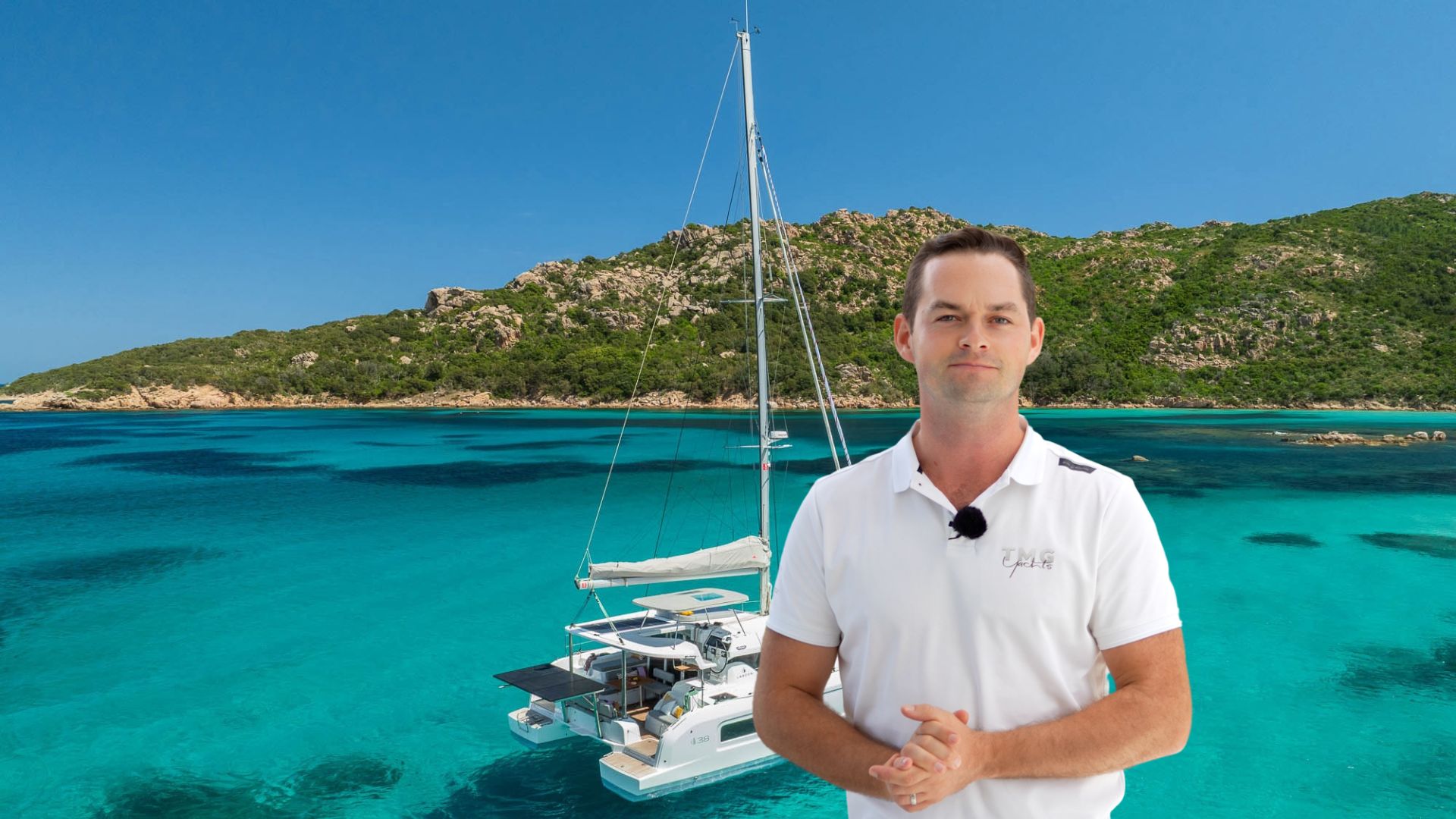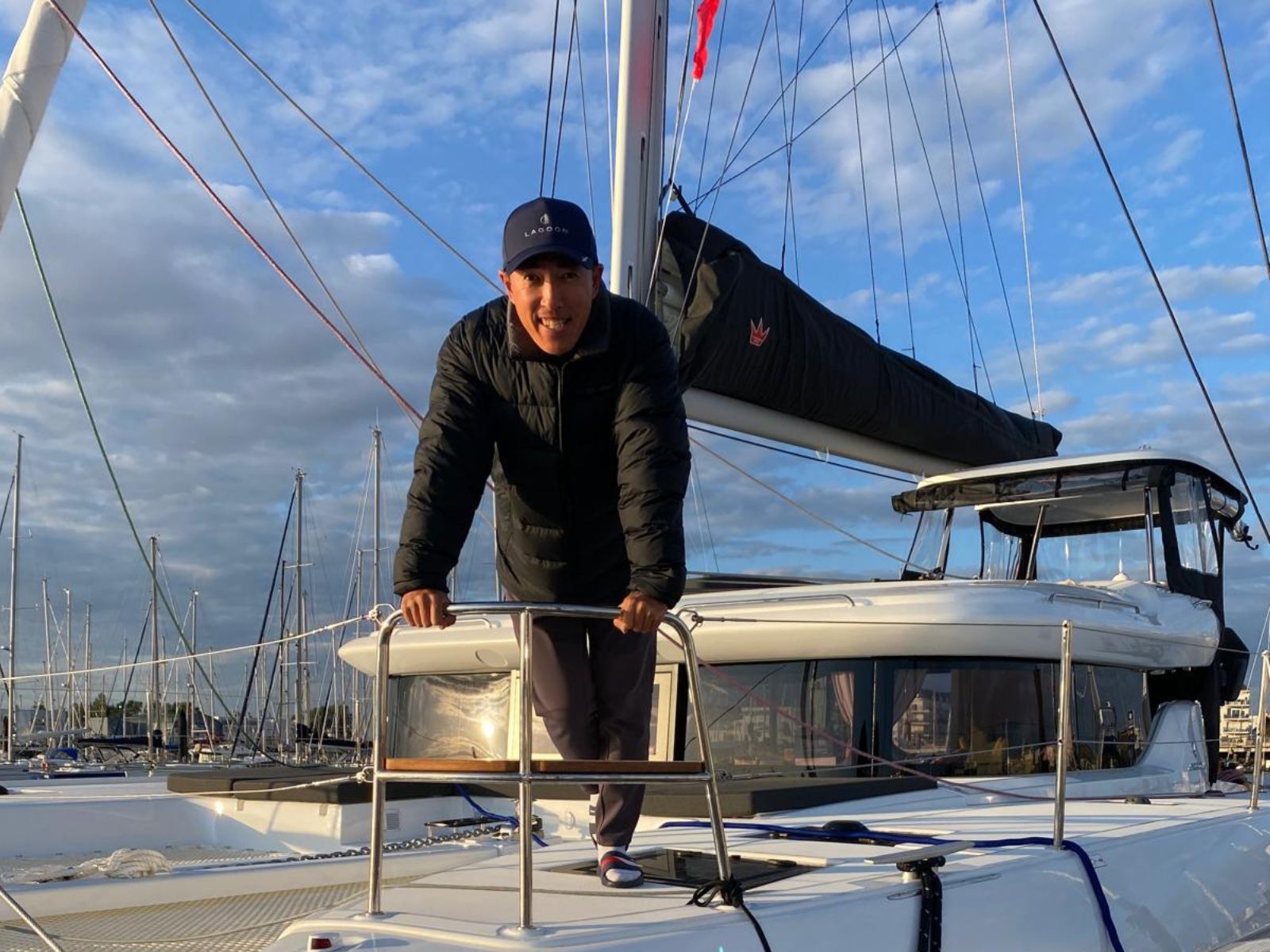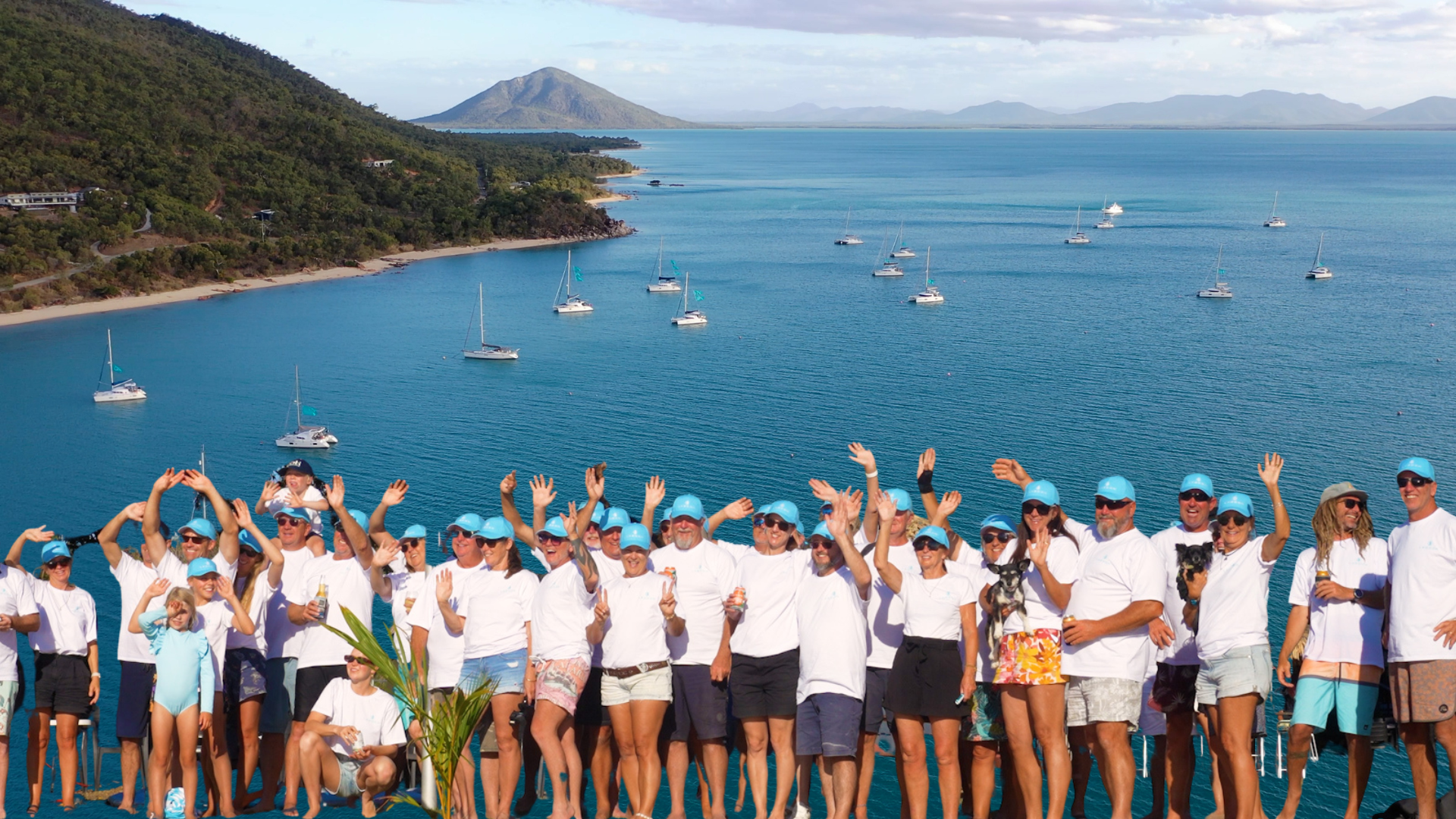46 vs 450


An in-depth analysis of the New Generation Lagoon 46 in comparison to its predecessor the Lagoon 450F
by The Multihull Group
Exterior design – Patrick le Quément | Interior Design – Studio Nauta | Naval Architect – VPLP
Spec differences
LOA 30 mm longer
LWL 380 mm longer
Beam 230 mm wider
Draft No change
Air draft 2.02 m taller
Dry Displacement 300 KG less
Engine power no change
Fuel capacity no change
Total sail area 11m² larger
Mainsail 10.8m² larger
Furling Self-Tacking Genoa 0.2m² larger

Sail Area to Displacement Ratio (SA/D)
The sail area to displacement ratio is used to compare the power-to-weight ratio of any vessel on a level playing field. A yacht having a sail area-displacement ratio of less than 15 would be considered under-canvased; values above 15 would indicate reasonably good performance; and anything above 18 to 20 suggests relatively high performance, provided the boat has sufficient stability to take advantage of its abundant sail area.

Lagoon 450F = 19.9
Lagoon 46 = 21.9
There are several reasons for this increase in power to weight ratio from the 450F to the 46
- The taller mast on the 46 with a larger mainsail provides more power
- The Genoa, although self-tacking has not lost any sail area in order to pass in front of the mast do to the relocation of the mast.
- Using modern moulding techniques not yet seen in the rest of the production yacht market, Lagoon are able to significantly save on weight despite the additional volume of the 46 over the 450F
The SA/D ratio of the Lagoon is greater than that of the market competition including the Leopard 45, Fontaine Pajot 45 and Bali 4.546 using the same calculations.
Living Area Comparison
| Lagoon 450F | Lagoon 46 | |
| Fwd Cockpit | 3.7m² | 4.3m² |
| Aft Cockpit | 17.4m² | 19.8m² |
| Salon/Galley | 13.9m² | 19.2m² |
| Total | 35m² | 43.3m² |
Accommodation Comparison
| Lagoon 450F | Lagoon 46 | |
| Port Bow cabin | 8.0m² | 9.0m² |
| Port Aft Cabin | 9.4m² | 11.0m² |
| Owner Area | 17.4m² | 20.0m² |
Overview – Internal Comparison
- All the internal living areas have increased in area from the 450F to the 46 by an average of 16%. This is thanks to the extra beam and significant space saving chines on the exterior. Providing a natural ducting for plumbing and systems thus freeing up more space in the cabins.
- The galley on the 46 is of a more ergonomic design than the 450F, removing bulky furniture from the middle of the salon, allowing for a larger salon table and fixed bench seat.
- For the first time on this sized Lagoon the forward cabin has the same size bed as the aft cabin. Again, this is due to the chines on the exterior of the hull, allowing greater interior volume without compromising on the hull shape in the water. The bed in the forward cabin is semi walk around like in the aft cabin.
- A significant improvement in the owner’s cabin is the introduction of a private toilet, separate from the shower/vanity unit, giving a private yet more usable space.
- Natural light in the cabins has been significantly improved with the addition of larger tinted windows. Previously much smaller on the 450F these illuminate the whole cabin with daylight creating natural ambiance with minimal input needed from cabin lights
- The internal bulkheads on the 46 have been incorporated into the cabinetry and design, increasing the internal space and creating a more open feel in large areas such as the owner’s cabin.


A revolution in rig design from VPLP
In line with many of the modern racing multihulls, the theory of mainsail design has changed significantly in recent years. Whereas previously a long boom and a large powerful mainsail accompanied by a large overlapping genoa were the standard, the new Lagoon sail plan has changed significantly as detailed below to create an easier to manage and efficient sail plan.
- The mast has been moved significantly aft from the front of the coach roof on the 450F, to just in front of the helm on the 46. This allows for several features as outlined;
- A shorter boom creates a taller aspect ratio mainsail. This is easier to manage and creates a more efficient sail combined with the square top main.
- Without reducing the size of the genoa, it enables a self-tacker to track in front of the mast, making maneuvering shorthanded a simple task for all.
The centre of effort on the rig has been moved aft giving more lift to the bows when sailing downwind.
The cockpit and aft deck Area

The aft cockpit is a focal point for many owners due to its extensive use and its practical layout. Having taken feedback from the 450F, Lagoon have adapted the cockpit on the 46 to encompass many of the missing features on the 450F.
- The 46 features a one level aft cockpit from the transom steps all the way through to the front of the saloon. Due to the structural design of the 450F the aft cockpit was on two levels with a raised walkway at the stern. The open style cockpit is much less cramped with more room for personal space and movement.
- Noting the “openness” of the low transoms we spoke with Marc Van Peteghem (The VP in VPLP). The bridge deck clearance is the same as the 450F due to the structural cross beam under the bench seat. The increased volume in the sterns means that a following sea will lift the transom with ease making the aft end of the boat safe in a following sea.
- On the starboard side of the cockpit on the 46 there is an outside sink and worktop. While the worktop was a feature on the 450F the sink is an addition on the 46.
- The width of the transom scoops has grown significantly providing a large and workable platform at the stern.


- The aft cockpit on the 46 features a modular design, allowing flexibility for seated numbers around the table. The bench seat can slide fore and aft depending on requirements.
- While the table on the 46 appears at first to be smaller its folding leaves add to the versatility of the cockpit, working in conjunction with the sliding bench.
- The introduction of cup and glass holders throughout the aft cockpit increase its usability at sea.
Flybridge and forward Cockpit Area
- The flybridge features a large lounging area aft of the helm, this has easier access than the previous lounging area on the coach roof on the Lagoon 450F. The flybridge is often the place to be with many clients sleeping up there while on passage on warm summer nights.
- A hard-top Bimini on the 46 provides significant sun protection as well as a sturdy platform with easy access for final stowing of the main sail. It features two tinted skylight panels for visibility to the main sail and mast top. The hard top bimini was not available as an option on the 450F from the factory.
- The Helm seat can be configured as a double cushioned seat, or full width bench seat depending on demand with seating for up to 5 people.
- A centralised wheel and helm station provides good visibility down both sides of the boat. The 450F helm station was offset to starboard, restricting the view down the Port side significantly.
- The forward cockpit is larger and more spacious than on the 450F, with a cover for the anchor winch when not in use, it is a safe area with good communication with the salon through the large sliding window as seen part open in picture below.
- The main sail boom bag has been redesigned with longevity and ease of use in mind. The standard zipper has been removed, replaced by overlapping flaps, fastened securely by weighted straps. This limits the amount of perishable plastic on the bag, extending its overall lifespan.


Exterior Styling
The exterior design by Patrick Le Quément is featured on all the new generation Lagoons as seen on the 40, 42 & 50. Several technological advancements have allowed for a significant change in the exterior design of the Lagoon 46. With the development of injection moulded fibreglass, the design of the Bimini and coach roof have improved significantly, allowing smoother and cleaner looking lines. The major changes in styling are detailed below.
- The introduction of flush hatches recessed into the deck is a huge leap forward in making the deck a safer place. Reducing trip hazards and removing the chance for sheets and lines to catch underneath them.
- The wrap around salon window carries its lines all the way to the back of the coach roof, creating a floating Bimini effect, improving the overall look of the deck house creating an elegant look.
- The large hull windows are accentuated by the elegant framing underneath. This framing provides protection to the windows as well as providing greater internal volume.
- While the hulls appear wider above the waterline on the 46, the wetted area is similar to the 450F. This is thanks to the chine that can be seen on the side of either bow. This creates more deck space as well as significantly larger cabins below decks as mentioned previously.

While the 450F and the 46 are closely related, the different between them is typical of the design and technological advancements that Lagoon and VPLP are renowned for.
– Best balance between price, performance and comfort
– The richest standard equipment and the most generous offer in features.
– The largest forward cabin bed on the 45’ market
– A rich and trendy interior design (Made in Italy)
– Mast moved 53% aft from bow: by far the best on the market whereas most competitors are still around 45% or less.
LATEST FROM THE BLOG
Discover the Brand New Lagoon 38: A Revolution in Entry-Level Cruising Catamarans
The Lagoon 38 is the newest evolution in entry-level cruising catamarans, replacing the legendary Lagoon 380. Combining spacious single-level living, smart storage, and efficient sailing performance, this compact 38-foot catamaran delivers big-boat comfort in a highly versatile package. Perfect for entertaining, extended cruising, or bluewater adventures, the Lagoon 38 sets a new standard for modern catamarans.
Lagoon 43 Review: Why This Well-Researched Choice is the Best Catamaran for Liveaboard Cruising
In this Lagoon 43 review, discover why Long chose this catamaran for his global voyage and how TMG Yachts supported him from the first inquiry to the European handover. Learn what makes the Lagoon 43 one of the best catamarans for liveaboard cruisers, especially for those seeking confidence, comfort, and long-range capability from day one.
Whitsundays Lagoon Escapade 2025 Highlights: Sailing, Games & Community
The Whitsundays Lagoon Escapade 2025 brought Lagoon owners together for two unforgettable days at Cape Gloucester. Against a backdrop of turquoise waters and golden beaches, the event was filled with sailing, games, sunsets, and community spirit. From the iconic Lagoon flotilla to beachfront banquets, paddleboard races, and shared stories, it was a celebration of connection and life on the water.



